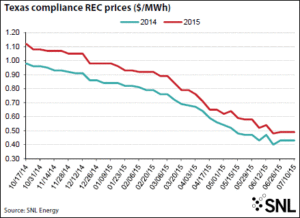In Texas, renewable energy credit prices remain weak, holding well below $1/MWh, amid a host of factors, including ample supply and anemic demand, with the potential for any upside traction appearing scant.
With a host of new renewable generation in the queue, Texas already boasts an enormous supply of installed wind generation capacity. According to the Electric Reliability Council of Texas Inc., installed wind capacity in Texas totaled 13,060 MW as of April 30, with 3,396 MW noted as planned 2015 capacity with signed interconnection agreements and financial security posted.
“Supply and demand are coming into play finally. The Texas RPS market is extremely oversupplied, and there is plenty of new construction planned.” Ryan Cook, vice president at Clear Energy Brokerage & Consulting LLC, said.
However, most of the wind capacity being built in the Lone Star State is due to the economics of the power markets as well as the federal production tax credit.
“Essentially, there is no REC driver for that amount of build in Texas. So, with this amount of installed capacity, we have a huge amount of REC supply and a fairly weak RPS in the state,” Jonathan Burnston, a partner in the Energy and Environmental Markets Group at Karbone Inc., said. “A huge amount of supply and a weak RPS, i.e.: a weak embedded compliance demand in-state.
Proportionately, roughly 40% of consumption, or demand, for Texas wind RECs came from compliance buyers while there has been an RPS, with the remaining 60% being bought by voluntary buyers both in-state and out.”
In the over-the-counter markets, calendar year 2015 Texas Green-e wind RECs were assessed at 65 cents/MWh to 85 cents/MWh as of May 26, according to SNL Energy data.
Softness in the national Green-e voluntary REC market is also keeping a lid on Texas Green-e and compliance REC prices at the moment. As of the May 26, national Green-e national market prices for 2015 were eyed at 40 cents/MWh to 55 cents/MWh.
At the OTC compliance markets in Texas, REC prices for 2014 and 2015 were sitting on either side of $1.00/MWh in December 2014 and have tipped lower gradually over the ensuing months. As of the week ended May 22, SNL Energy data showed Texas compliance RECs for 2014 priced at an index of 48 cents/MWh, with the 2015 REC market assessed at an average 59 cents/MWh, easing 4 cents and 5 cents, respectively, from the week before.
Market sources also attributed the weakness in Texas REC markets in recent weeks to the expectation that legislation that would repeal the state’s RPS at the end of this year would be passed. The legislation, sponsored by Republican Sen. Troy Fraser, and passed in the Texas Senate previously, was drafted to terminate the state’s 10,000-MW renewable portfolio standard and transition the mandatory renewable energy credit program to voluntary.
The Texas Legislature established the RPS as part of the restructuring of the state’s electricity market in 1999 to increase incentives for renewable energy production. The PUC implemented the REC program in 2001, and ERCOT began administering the program at the PUC’s direction. The Texas RPS initially required 2,000 MW of new renewable energy capacity to be installed statewide by 2009. In 2005, the program was expanded to accommodate 5,880 MW by 2015 and included a target of 10,000 MW by 2025. In early 2010, Texas reached the 10,000 MW goal 15 years ahead of schedule.
Renewable energy generation in Texas increased 10% on the year in 2014, the grid operator for most of the state, ERCOT said. For 2014, renewable facilities in Texas generated almost 42 million MWh in 2014, up from 38.1 million MWh in 2013 and 33.9 million MWh in 2012, according to the Texas renewable energy credit program annual report, filed with the Public Utility Commission of Texas.
At about 40.6 million MWh, wind generation continued to account for the largest share of the total figure for the year. Solar generation was pegged at 312,757 MWh in 2014.
Despite the year-over-year growth, total electricity generated by renewable energy in Texas still represents a fraction of the state’s total. According to data from the U.S. Energy Information Administration as of January 2015, natural gas comprised 50.6% of the state’s total share of electricity generation, while coal represented 30.1%, nuclear accounted for 10% and renewables represented about 8.5%.
In Texas, the compliance, or true-up, period each year is March 31. Per annum, retail electric providers must acquire and retire RECs based on their load-ratio share of the state’s RPS. The entities may voluntarily retire RECs as well. A REC represents 1 MWh of renewable energy produced.
In 2014, voluntary and mandated REC retirements increased from the year prior. Through March 31, 2015, more than 9.46 million RECs were voluntarily retired for compliance year 2014, up from 7.4 million voluntary RECs retired through March 31, 2014, for compliance in 2013. In compliance with the Texas RPS, in the mandatory market, the state’s competitive retail electricity providers retired more than 14.8 million RECs in 2014, up from 12.4 million RECs in 2013, 12.1 million in 2012 and 9.03 million in 2011.
Generally, there are two types of compliance buyers in Texas — big utilities that often purchase RECs in large quantities, and other retailers that often buy RECs in smaller batches. The small retailers typically wait to satisfy their obligations, coming to the market in the final month of the true-up period. Quite often, during the first quarter of the year, the compliance REC market in Texas will see a small increase in value, as participants rush in to satisfy obligations. But amid the backdrop of oversupply, the bump up in prices failed to materialize this year. And since entities only filed their compliance reports, participants are not really looking ahead to satisfy 2015 compliance obligations in Texas just yet, leaving REC prices in the state stalled at such paltry levels.
Market prices and included industry data are current as of the time of publication and are subject to change. For more detailed market data, including SNL power and natural gas index prices, as well as forwards and futures, visit our SNL Commodities pages.






